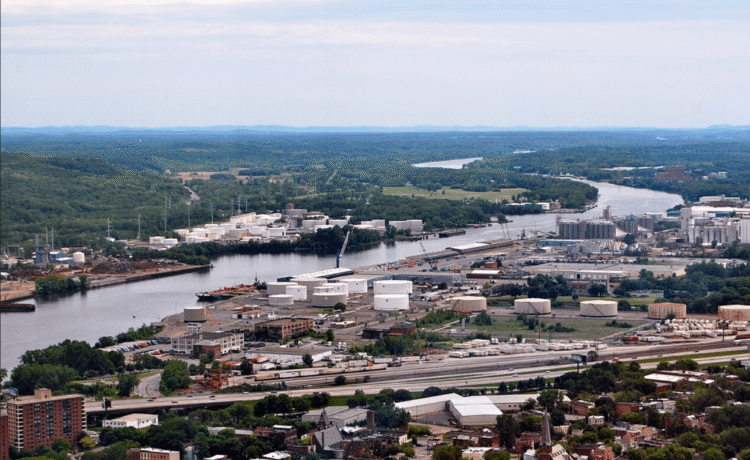
 The Port of Albany is one of the five Upstate New York State port authorities, established for the economic development and the pursuit of waterborne commerce, in coordination with its host cities and the State. The other four ports are Buffalo, Oswego, Rochester, and Ogdensburg.
The Port of Albany is one of the five Upstate New York State port authorities, established for the economic development and the pursuit of waterborne commerce, in coordination with its host cities and the State. The other four ports are Buffalo, Oswego, Rochester, and Ogdensburg.
Albany, the Capital City of the Empire State has been a center of commerce for eastern New York State and western New England for over four hundred years.
For its Dutch-founding traders, later English settlers, and then millions of immigrants transiting to beyond, this community at the northern navigable terminus of the Hudson River was an important entry point to America’s interior.
The completion of the Erie Canal in 1825 opened Albany’s commercial influence to the Great Lakes Region, as did also the emergence of the railroads. (A significant railroad terminal and repair yard was located in West Albany.)
So, Albany became a commercial center, because of its river and access to the interior. As time passed, it also became a governmental center, but its commercial importance has remained.

 Industries in Albany and the neighboring cities of Troy and Schenectady, at from the early-19th and throughout much of the 20th Century, were of national importance, especially milling, lumber, textiles and manufacturing; and later future giant individual corporations like General Electric and American Locomotive.
Industries in Albany and the neighboring cities of Troy and Schenectady, at from the early-19th and throughout much of the 20th Century, were of national importance, especially milling, lumber, textiles and manufacturing; and later future giant individual corporations like General Electric and American Locomotive.
The Development of A Modern Port
Until the beginning of the 20th century bars and shoals made Hudson River navigation difficult, especially for large ships.
The challenge of developing an organized, modern public port for the region, with sufficient depth of water from New York City to Albany to accommodate the ocean vessels of the day, was an issue addressed in the Rivers and Harbors Act of 1915.
Following an estimate of the cost of a deep-water channel survey, and with the support of leading citizens, in 1925 Congress authorized dredging, but the cities of Albany and Rensselaer were required to construct the terminals.
(In 1925 the river was dredged to 27 feet; since 1965 channel depth has been increased to 32 feet.)
New York State’s legislature passed a law within the same month creating the Albany Port District Commission, thus establishing the legal and financial standards of this special government district.
The Albany Port District Commission is a public corporation with perpetual existence and has the right to eminent domain with power:
“to construct, develop and operate Port facilities including a railroad type operation; to fix fees, rates, rentals, and other charges for its facilities; to regulate and supervise the construction and operation of Port facilities by private enterprise; to issue bonds and rates and to do all things necessary to make the Port useful and operative.”
Additionally, the law organized the commission with five commissioners, with regulatory power over the development of the Port, while the two host cities Albany and Rensselaer would be assessed for any budget deficit.
The commissioners were to be appointed by the Governor of New York State (then Alfred E. Smith) for three-year terms, with four members nominated by the Mayor of Albany (William Hackett) and one member by the Mayor of Rensselaer (Walter Hollinger).
Since its establishment by law in 1925 and dedication and opening in 1932, the Port has seen many changes, and contributed to some of them. A review various of annual reports over the years shows its continual strength in the shipping of grain, scrap iron, and molasses, as well as lumber.
Economic Difficulties & A Modern Rebound
In the late 1960s and early 1970s, with a downturn in economic activity in the region, the Port’s revenues faltered (to a $7.8 million deficit) and significant infrastructure repairs and upgrades were delayed.
During the 1980s and 1990s, as well the first decades of the 21st Century, the Port has modernized its equipment and port infrastructure, as well as pursued other economic opportunities within its physical limits or by purchasing additional land, while remaining fiscally solvent.
These improvements have relied on federal and New York State grants, including recently, those from the U.S. Department of Transportation’s “Transportation Investment Generating Economic Recovery” (TIGER) program; the New York State Department of Transportation; Empire State Development; Capital Region Economic Development Council (CREDC), and private investors.
Specifically, in 2024, “the Port completed reconstruction of the maritime terminal (approximately 17 acres within a 30-
acre maritime terminal complex, including adjacent roadways) – the first time the entire terminal was reconstructed since the Port’s opening in 1932.
Also, the Port was awarded a $9.9 million grant in 2023 from the New York State Department of Transportation “Passenger and Freight Rail Assistance Program” (PFRAP) for upgrades to its heavy rail and on-deck wharf system [the concrete support for handling areas] at the Port’s existing maritime terminal.”
Another ongoing commercial enterprise since 2018 has been the Port’s purchase of the 85-acre Beacon Island as an expansion site, adding 25% to the land area of the Port District.

 As of 2024, that site has been fully permitted for offshore wind supply chain manufacturing and related maritime operations. As a result, the Port of Albany has been described as “the largest fully permitted Port site for wind manufacturing on the East Coast.”
As of 2024, that site has been fully permitted for offshore wind supply chain manufacturing and related maritime operations. As a result, the Port of Albany has been described as “the largest fully permitted Port site for wind manufacturing on the East Coast.”
Also of note, “the Beacon Island Expansion project received an $18.79 million grant in 2025 from the Empire State Development’s Focused Attraction of Shovel-Ready Tracts New York (FAST NY) program for a high voltage substation, a sanitary wastewater treatment plant, and the intake lines and pump station for a fire protection system.
“With more than $170 million of funding from New York State as part of this public-private partnership, however, due to changed economic and supply chain conditions [in 2025] considerations are now being made toward alternative projects.”
Previously, “in 2022, the Port had acquired the lease of another 42.5-acre lot with a connection to the existing Port facilities on the east side of the Hudson River, allowing for future, additional opportunities for growth, including the use of its existing on-site rail and power connection availability.”
Beyond the Port’s perimeter, and because of its long-time emphasis on maritime commercial development only, the Port of Albany has had very little direct influence in the revitalization of Albany’s downtown and central business district, as some other ports have led or assisted with such efforts.
Yet, the Port is an active community member, supporter, and advocate in the Downtown and South End neighborhoods in Albany, as well as in planning efforts with the City of Rensselaer, and most recently, with the Town of Bethlehem, as it adjoins the Port’s expansion site on Beacon Island.
Port Development and Commerce – Does it Make a Difference? And To Whom?
The Port of Albany is not unique in its history and development. Many of the port cities along the East Coast of the United States could report a similar beginning and gradual growth into a port of value to a city, a region, a state.
As stated by John M. Pisani, former Director of the Office of Port and Intermodal Development of the Maritime Administration, U.S. Department of Transportation:
“The ports of the United States play a strategic role in the nation’s trade, economy, and defense. Since its founding days, the United States has been dependent on water transportation for trade, and today every major metropolitan region of the United States centers around or is closely linked by rail or highway with, a port. The end result has been the
creation of a vital network of ocean, Great Lakes, and inland river ports.
“Functionally, deep-water and shallow-draft ports are the conduits for transferring cargo between water and land carriers. Their principal reason for being, however, is to further the economic development of surrounding communities by creating jobs, income, and tax revenues. Thus U.S. ports mirror the economics of the regions they serve. They are
sensitive to population and industrial growth, raw material patterns, and government policy.”

 In further describing a modern local port, Mr. Pisani had described public port authorities such as Albany as “the primary developer of transfer facilities for handling cargo… the independent navigational district, administered as a public authority set up under state law to develop and manage a specific harbor area within defined political jurisdiction.”
In further describing a modern local port, Mr. Pisani had described public port authorities such as Albany as “the primary developer of transfer facilities for handling cargo… the independent navigational district, administered as a public authority set up under state law to develop and manage a specific harbor area within defined political jurisdiction.”
In the early 1990s, The American Association of Port Authorities reported that “in 1993 roughly one-third of the total volume of U.S. foreign commerce” was shipped through facilities owned or operated by America’s public ports.
The U.S. Maritime Administration reported that in 1992 “commercial port activities resulting from cargo operations accounted for 1.5 million jobs; contributed $74 billion in gross domestic product; provided personal income of $52 billion; and generated $14.5 billion in federal taxes and $5.5 billion in state and local taxes.”
The 2024 U.S. Port and Maritime Industry Economic Contribution Report of the American Association of Port Authorities indicated that “the maritime industry, its consumer spending, suppliers, and port users support 21.8 million American jobs (one of eight jobs in the total U.S. workforce) and contributes nearly $2.59 trillion to the national GDP.”
The Port of Albany’s 1998 Annual Report indicated that 321,186 metric tons of cargo were handled. In 2024, the Port reported 233,015 metric tons of cargo from 53 visiting ships and barges.
As noted earlier, the use of the public port is one tool available to a city and a region’s economic viability. But the establishment and maintenance of a public port is not without cost. David Morgan and Robert England in Managing Urban America stated:
“Financing a host of public improvements is a major strategy employed by local governments on behalf of economic development… Public spending for development-related infrastructure must compete, of course, with other potential uses for those dollars. On what basis might a city government decide to spend public funds for projects designed primarily to facilitate or aid private development?…
“New tax revenue may be generated in several ways, not only from the construction of new buildings, but also from the creation of new jobs and the inducement of surrounding businesses to upgrade and improve their structures.”
To this environment of a city or cities wanting to expand economic infrastructure, with limited resources to use for such an expansion, comes the “Special District” or “Authority” as a mechanism for making the concept a reality:
“In contrast to cities, special districts are independent local governments that generally perform only a few local government functions. They can tax, float bonds, and provide services. They are not accountable to other governments…
“Generally, they perform one single function. These governments have territorial boundaries. However, they have geographic flexibility that other governments do not have.”
Paul Peterson, in City Limits, described this enterprise as: “The consensual politics of development is illustrated by the frequency with which responsibility for developmental policy is granted to groups and entities outside the mainstream of local politics…
“In larger cities and metropolitan areas, important developmental policies come under the direction of independent authorities… The secret to the autonomy of these independent authorities lies in their self-financing capacities… a
dependable source of income free of the usual political constraints.”
Additionally, “States assist their ports through a variety of funding options. Many states finance port projects through general obligation bonds, revenue bonds, or more specifically, transportation bonds…”
The Port of Albany has followed the form of organization and finance described above, with some modifications. As described in its authorizing legislation, it does not have now, nor had it ever, the authority to tax.
It was designed to be self-financing, but the original Act had a relief mechanism, “that the municipalities of Albany and Rensselaer shall be assessed for the commission’s estimated budget deficit.”
A reapportionment determination made April 1, 1932, established that Albany would assume 87.89% of the deficit and Rensselaer 12.11%.” That legal foundation and funding arrangement remains in force today.
Since its inception, the Port’s revenues have been obtained by maritime fees; facility charges; and receipt of New York State and federal grants for capital projects. Such governmental grants remain inconsistent and variable by project.
Review of the Port’s history since 1925 also revealed discussion in studies and planning documents during the late 1960s through the early 1970s of recommendations to have the Capital District Transportation Authority (CDTA), another New York State “special district,” assume operational authority for the Port, so to “broaden the base of support” and overcome the deficit condition and infrastructure problems the Port was experiencing at that time.
That recommendation was never implemented and the Port remains a stand-alone operation still to this day.
Finally, the Port of Albany’s organization as a Commission was from the beginning comprised of leading citizens of the business community with an interest in the economic success of this region of New York State.
According to Peterson funding of the Albany Port District Commission and its subsequent management since its founding, have been similar to his definition of the politics of development:
“The politics of development is particularly enticing to otherwise apolitical businessmen, because successful effort on behalf of a project that benefits the community as a whole has a halo effect.”
These types of “positive” achievements and impact have been regularly reported by the Port of Albany, including most recently when a study measured the Port’s overall economic impact on New York State at more than $813 million.
“The measure of the Port’s significance to the regional economy in terms of output was more than $428 million. Tenants of the Port paid over $80 million in wages and benefits for approximately 1,400 local jobs and 4,500 jobs throughout New York State,” it found.
This article was drawn from a much longer paper originally submitted by Joseph Fitzgerald as a Capstone Project for his Master of Public Administration at the University of Memphis in 1999.
Its has been updated to reflect the progress, as well as ongoing challenges and opportunities, facing the Albany port authority, as it approaches the Centennial Celebration of its Dedication Ceremonies (June 6 -7, 1932) in 2032.
Illustrations, from above: View of Port of Albany and Rensselaer from the Corning Tower, 2009 (courtesy wikimedia user UpstateNYer); A Swedish ship unloading wood pulp at Port of Albany in the 1930s (courtesy Albany Hall of Records); cargo ready to be shipped at Port of Albany, ca. 2024 (courtesy Port of Albany); Tracer, a heavy-lift vessel operated by BigLift Shipping, a Dutch company specializing in the transportation of heavy and oversized cargo, at the Port of Albany in September 2025 (courtesy Port of Albany).








Recent Comments